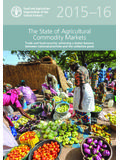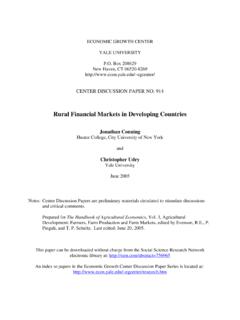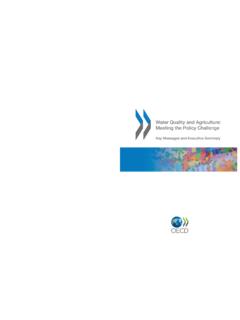Transcription of The State of Agricultural Commodity Markets IN DEPTH
1 2015-16 The State of Agricultural Commodity Markets IN DEPTHWhat are the issues?In the wake of the 2007-08 food crisis that brought higher and more volatile food prices, many countries expressed increased interest in pursuing policies to bolster their levels of food self-sufficiency. At the same time, there has also been widespread critique of policies designed to support food self-sufficiency, on the grounds that they are inefficient and can disrupt trade. This debate has typically been cast as one in which political considerations clash with economic reasoning, resulting in costly outcomes. The dynamics of this debate are an important backdrop in the context of attempts to finalize the Doha Round Agreement on Agriculture at the World Trade Organization (WTO).
2 The aims of this Note are to clarify the terminology and definitions associated with the concept of food self-sufficiency, to provide some historical context regarding the application of policies that support this objective, and to outline the debates surrounding those policies. The analysis shows that debates over food self-sufficiency have been cast in black and white terms, with critics of the idea defining it in its most extreme form of complete rejection of all food trade. In practice, self-sufficiency is more of a relative concept along a continuum. Conceptualizing food self-sufficiency along a continuum can help move the debate forward in more productive ways, and reveals that there are a number of instances when pursuing policies to increase a country s own food production for domestic consumption may be beneficial both economically and politically.
3 1 This technical note was prepared for The State of Agricultural Commodity Markets 2015 16 by Jennifer Clapp (Canada Research Chair in Global Food Security and Sustainability. Professor, Environment and Resource Studies Department, University of Waterloo, Canada).Food self-sufficiency and international trade: a false dichotomy?1 The State of Agricultural Commodity Markets 2015-16 IN DEPTH2 There are multiple understandings of food self-sufficiency that can apply at different levels of analysis (O Hagen, 1975). According to FAO, The concept of food self-sufficiency is generally taken to mean the extent to which a country can satisfy its food needs from its own domestic production (FAO, 1999).
4 This most basic definition can apply at the level of individuals, countries, or regions. In the context of debates on trade and food security, self-sufficiency typically refers to countries that seek to produce all or most of their own food for domestic consumption. Figure 1 depicts this most basic understanding of food self-sufficiency, with the line representing where food production is equal to food consumption within a country. Individual countries can be plotted onto the diagram to show whether they fall above or below the self-sufficiency line (O Hagen, 1975; Josling, 1975; Porkka et al., 2013). In this figure, the axes could indicate total food production annually or per capita food production per day.
5 Although this basic definition is what most people think of when they hear the term food self-sufficiency, there is a lack of clarity on details when the concept is applied in practice. For example, if a country claims to be self-sufficient in food, does this mean that it does not engage in any international trade in foodstuffs? The answer to this question depends on how one further clarifies the definition of food self-sufficiency and how that understanding guides government policy one extreme, food self-sufficiency can be defined as a country closing its borders to all food trade both imports and exports and concentrating its resources on its agriculture sector so as to be able to produce all of its food requirements domestically.
6 In other words, this definition refers to a State practicing complete autarky in its food sector. Such an extreme policy stance does not apply in practice today, just as there no countries that practice completely free trade and rely on foreign Markets for 100% of their food. All countries, even large food exporters that are fully self-sufficient, typically import at least some food. Even North Korea, the country with perhaps the most isolationist policies, still relies on some imports and food assistance for a portion of its domestic food needs (FAO, 2015). A more practical application of the concept of food self-sufficiency is defined as a country producing a proportion of its own food needs that approaches or exceeds 100 percent of its food consumption.
7 This definition does not exclude trade as a possibility, and instead expresses food self-sufficiency as a percentage, or ratio of consumption. This definition is less absolute with respect to where food is sourced, but still gives an idea of a country s self-capacity for food production. Countries that are self-sufficient may specialize their food production to some extent and import as well as export food. But in caloric terms, a self-sufficient country produces as much or more food than it consumes, even if some of the actual food items consumed by its population are different from those that it produces domestically. This more pragmatic understanding of food self-sufficiency is captured by what the FAO terms the self-sufficiency ratio (SSR), which is defined as the percentage of food consumed that is produced What is food self-sufficiency and how is it measured?
8 Figure 1: Basic representation of food self-sufficiencySource: self-sufficiency and international trade:a false dichotomy?3domestically (FAO, 2012). The SSR is measured using the following equation with respect to food production and trade:Production x 100 / (Production + Imports Exports)More precise measurements of the SSR also include changes in domestic stock levels (Puma et al., 2015). The SSR is typically measured in calories or in volume of food produced, although it can also be expressed as a ratio of monetary value. The SSR can also be measured in terms of a specific Commodity , such as wheat, maize, rice or diary, to give an indication of a country s capacity to produce its own needs for these commodities.
9 Another measure that captures self-sufficiency levels of countries focuses on dietary energy production (DEP) per capita within a country. This measure considers those countries that produce over 2500 kcal per capita per day to be self-sufficient as it is over this threshold that caloric intake is deemed to be required for an adequate diet (Porkka et al., 2013).2 Food self-sufficiency is related to, but not the same as, measures of net food importing and net food exporting countries, which indicate whether countries import more than they export or vice versa. However, most net food exporting countries are self-sufficient by the SSR and DEP measures, and most net food importing countries are not considered self-sufficient by those Using the SSR and/or DEP measures of food self-sufficiency, a country can be considered self-sufficient while still engaging in food trade.
10 2 There are different interpretations of what constitutes an adequate diet in terms of caloric intake. Other factors besides calories also matter for adequate diets, including the nutritional content of the food. The caloric focus here merely captures the macronutrient needs for an adequate is important to note that food self-sufficiency is not an expression of food security, although the two can interact in important ways. The concept of food security does not include a consideration of the origin of food or a country s capacity to produce it, so long as it is available, accessible, nutritious, and stable across the preceding three elements. Food self-sufficiency is mainly concerned with the availability ( supply) pillar of food security, and focuses on origin of food, or at least the domestic capacity to produce it in sufficient quantities.

















